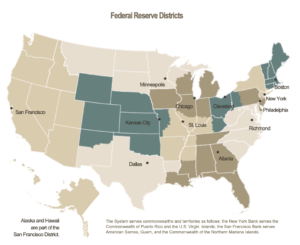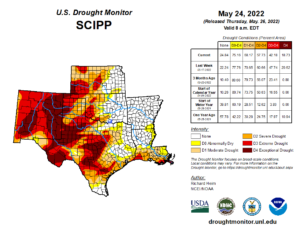Agriculture leaders in the United States House of Representatives are looking to provide at least an additional $10 billion in farmer aid to supplement the recently announced Farmer Bridge Assistance…
Federal Reserve: Observations on the Ag Economy- May 2022; Commodity Prices, Input Costs, Cropland Values all Climb
On Wednesday, the Federal Reserve Board released its May 2022 Beige Book update, a summary of commentary on current economic conditions by Federal Reserve District. The report included several observations pertaining to the U.S. agricultural economy.

* Sixth District- Atlanta– “Agricultural conditions remained mixed. Most of the District remained drought free. On a month-over-month basis, the May production forecast for Florida’s orange and grapefruit crops were below last year’s production. The USDA reported year-over-year prices paid to farmers were up for cattle, corn, cotton, eggs, milk, soybeans, rice, and broilers. On a month-over-month basis, prices increased slightly for cattle, corn, cotton, boilers, milk, and soybeans, but decreased for eggs; rice was unchanged.”
* Seventh District- Chicago– “Farm net income expectations for 2022 were little changed overall during the reporting period, as prices and costs increased by similar amounts.
Corn, soybean, and wheat prices were all up, as were prices for diesel and propane.
“Cool, wet weather slowed spring planting for corn and soybeans. In addition, concerns lingered about whether fertilizer would arrive at farms on time. Strong dairy exports helped boost milk prices. Bird flu continued to ravage poultry farms, pushing up egg prices. Hog prices moved sideways, while cattle prices were lower. As with crop farmers, livestock producers also faced higher input costs. Agricultural land prices continued to rise strongly.”
Nonirrigated Cropland Values- @ChicagoFed, @DallasFed, @KansasCityFed, @MinneapolisFed, https://t.co/74NJDaVQLY pic.twitter.com/4Tk7srxyTI
— Farm Policy (@FarmPolicy) June 1, 2022
* Eighth District- St. Louis– “Agriculture conditions have improved slightly since our previous report. Contacts reported thin margins despite increased commodity prices due to rising input and labor costs, but remain optimistic due to persistent high demand. Contacts noted that rising energy prices have created an unprecedented opportunity for alternative energy products and other new technologies in the sector. The percentage of row crops planted has increased since the previous reporting period, but is down from this time in 2021. Progress of acres planted is down this year for every crop and all states in the District, which reflects production issues due to staffing and supply chain concerns.”
* Ninth District- Minneapolis– “District agricultural conditions remained strong. According to the first-quarter (April) survey of agricultural credit conditions, 87 percent of respondents reported increased farm incomes relative to the same period a year earlier. Farmland values increased briskly.
Nonirrigated Cropland Values, First Quarter 2022, https://t.co/i4ZqcjqOdW
— Farm Policy (@FarmPolicy) June 1, 2022
* Add'l background, here: https://t.co/W4UCqqrLtX pic.twitter.com/hIA1kFfOzO
“However, due to an exceptionally cold and wet spring, crop planting and progress were well behind schedule in much of the District, except for Montana and western portions of the Dakotas, where drought conditions were rampant.”
* Tenth District- Kansas City– “Agricultural commodity prices remained at multi-year highs, providing ongoing tailwinds to the Tenth District farm economy. Market conditions remained favorable for prices of all major commodities in the region and prices of wheat, corn, soybeans, cotton and cattle increased modestly from the previous month. Farm income and credit conditions also improved further during the most recent survey period. However, contacts expected conditions to soften slightly in the coming months and many cited concerns about rising input costs, broad inflationary pressures and severe drought.
#Farm loan repayment rates increased at a pace similar to recent quarters in most regions and rose at a slightly faster pace in the @ChicagoFed and @MinneapolisFed Districts, https://t.co/74NJDbcTNY pic.twitter.com/7W4YnDMi2L
— Farm Policy (@FarmPolicy) June 1, 2022
“The western and southern portions of the region have been most exposed to drought, affecting wheat, hay and grazing conditions that could reduce profit opportunities for both crop and livestock producers in those areas.”

* Eleventh District- Dallas– “Drought intensified over the past six weeks, particularly in the western part of the district. Crop conditions generally declined, with increased risk of reduced yields for this year’s row crops. Forage conditions suffered from the lack of moisture, putting additional strain on livestock grazing amid highly elevated supplemental feed costs. This has led to increased culling of herds and lower calf prices. Agricultural product prices showed mixed movements over the reporting period but generally remained high. Despite high prices, contacts noted increased financial risk this year due to drought and higher input costs.”
* Twelfth District- San Francisco– “Conditions in the agriculture and resource-related sectors deteriorated a bit. Exporters of agricultural products faced more challenges due to further shipping bottlenecks and container shortages stemming from an appreciating dollar, the war in Ukraine, and the lockdowns in China.
Growers throughout the District noted rising costs for labor, fertilizer, and transportation, and one contact expected costs to continue accelerating in the near future.
“Another contact in the Pacific Northwest mentioned that these export challenges have led them to look at markets within the United States or Canada and Mexico.”





